07.27.2021
Energy Monitoring Systems Drive Sustainability and Operational Efficiency
I’m pleased to co-author this blog with Ben Austin of Findorff, a valued partner of Faith Technologies.
 Today’s facility environments are complex and can require active management to meet constantly evolving expectations. Building owners and operators must balance a wide array of needs across their portfolio and determine how their facilities and building systems can best support the goals of the organization. Central to these needs is a strategy to address energy efficiency, sustainability and resiliency within the building systems.
Today’s facility environments are complex and can require active management to meet constantly evolving expectations. Building owners and operators must balance a wide array of needs across their portfolio and determine how their facilities and building systems can best support the goals of the organization. Central to these needs is a strategy to address energy efficiency, sustainability and resiliency within the building systems.
Findorff and Faith Technologies have long provided sustainable building solutions to our clients. Whether the goal is to reduce energy bills, assess renewable energy options, help meet climate goals or improve the resiliency of your facilities, system improvements can be worth the investment.
The tools and data provided by an Energy Monitoring System (EMS) deliver clear measurements for sustainability goals and give our clients the data they need to make informed decisions. While there are a variety of strategies available to facility operators, an EMS presents the most significant opportunity to reduce energy costs, while also helping to assess power quality issues before they make a negative impact.
An EMS requires centralized software that should have the following capabilities:
- Trending and database storage of energy usage.
- Intuitive charts and dashboards that provide detailed information about the system’s health and chart real-time progress.
- User-friendly reports that can be easily shared.
- Alarming for down-time situations or issues that could lead to down time.
For electrical metering, typical systems include a power quality meter at the utility entrance to the facility and power usage monitoring at key points downstream. Lower-level metering may be required by LEED or ASHRAE, or to measure specific sustainability goals. The system can also be used to drive further efficiency tracking.
For other metering, such as natural gas, water or compressed air, intelligent or pulse meters are placed at the facility feeds, as well as downstream if data for departments or processes needs to be broken out separately.
While metering non-electrical energy sources can confirm usage and drive efficiency, there are several key benefits to monitoring an electrical system:
- Determining operational, process or equipment setting adjustments to lower usage or shave peaks.
- Alerting users to abnormal electrical conditions that would otherwise go unnoticed (i.e., power quality or peaks in usage). This helps avoid outages, down time or equipment failure.
- Providing data in the event of a circuit breaker trip, to prevent recurrences.
- Division of electrical bills, where allowed, to separate accounts or business divisions.
- Support of green building standards or facility sustainability goals.
Facility operators, armed with the information that an EMS provides, can assess their needs for the future. Typical questions we hear include:
- Where can we expand our facility with our existing electrical power distribution?
- How much energy is consumed compared to my other facilities or process lines?
- How much solar or other renewable power could our facility consume?
- How much energy does my new equipment use, compared to my old equipment?
Many clients question what the payback will be for an EMS at their site. This infographic shows some potential ROIs for a typical greenfield facility located in the U.S.: Facilities with very low utility rates or usage, or with one large electrical consumer, tend to have longer ROI timelines. It’s almost always the most cost effective to install metering equipment on a greenfield site during construction rather than retrofitting an operating facility later, where shutdowns will be required for the installation. Brownfield sites with existing facilities are also good candidates for installing an EMS to better understand power consumption and develop energy usage plans to optimize building performance while minimizing energy consumption. Here are some brief Budget Examples and Projected ROIs based on typical energy rates and pricing from July 2021.
Facilities with very low utility rates or usage, or with one large electrical consumer, tend to have longer ROI timelines. It’s almost always the most cost effective to install metering equipment on a greenfield site during construction rather than retrofitting an operating facility later, where shutdowns will be required for the installation. Brownfield sites with existing facilities are also good candidates for installing an EMS to better understand power consumption and develop energy usage plans to optimize building performance while minimizing energy consumption. Here are some brief Budget Examples and Projected ROIs based on typical energy rates and pricing from July 2021.
At Findorff and Faith Technologies, we provide our customers with technical solutions that drive results. An energy monitoring system helps customers reduce costs, prevent downtime and plan for the future. How can we support your energy monitoring needs?
If you enjoyed this blog article, please subscribe to stay up to date on the latest industry news from our experts at Faith Technologies.




